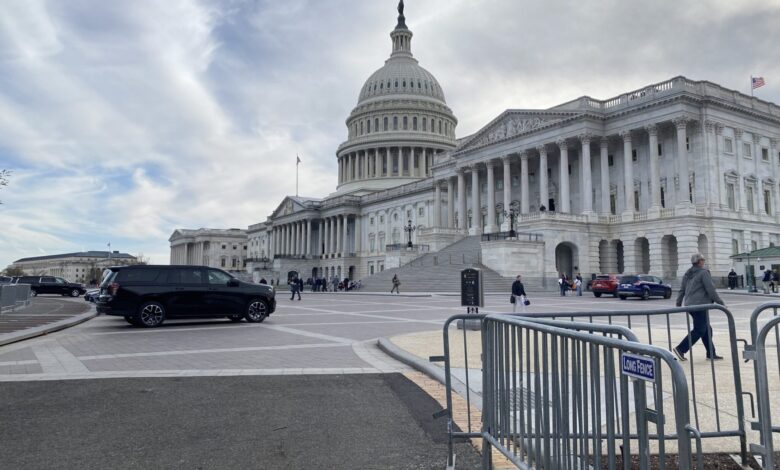Congress prepares to leave Washington after escaping government shutdown •

WASHINGTON — Congress overwhelmingly passed a stopgap spending bill Wednesday that would keep the federal government running through Dec. 20, though lawmakers would have to pass more than a dozen measures if they want to meet the new deadline. A full-year appropriations bill, a divided Congress still has a lot of negotiating to do.
The short-term financing bill, sometimes called a continuing resolution, would avoid a partial government shutdown when the new fiscal year begins on Oct. 1.
CR should give lawmakers more time to agree on an appropriations bill. But Congress often uses it as a safety net to delay or completely avoid decisions about which departments should get more money and whether to change federal tax spending policies.
The debate on the CR was largely bipartisan, with both Democrats and Republicans expressing support before it passed the House in a 341-82 vote vote The Senate voted 78 to 18.
President Joe Biden is expected to sign the bill before the Oct. 1 government shutdown deadline.
“There are still a lot of questions” ahead
The stopgap bill is the last major piece of legislation Congress will consider before Election Day. The lame duck session is scheduled to begin on November 12th.
“Within days, fiscal year 2024 funding will be exhausted, and Congress has a responsibility to ensure the government remains open and serving the American people,” House Appropriations Chairman Tom Cole, R-Okla., said during the House debate. “We are here to avoid harmful damage to our national security and the vital programs our constituents rely on.”
Cole said he hopes Congress will approve the dozen full-year bills later this year.
“The next president and the next Congress should not be forced to do the job of this administration and this Congress,” Cole said. “They’re going to have a lot of problems … and we’re not going to put a possible government shutdown in front of them.”
Rep. Rosa DeLauro, D-Conn., the ranking member of the spending committee, said lawmakers must begin in-session negotiations in the coming days to reach a bipartisan agreement on a full-year spending bill.
“No matter who wins in November, we owe it to the next Congress and the next president not to saddle them with yesterday’s problems,” DeLauro said.
Non-citizen voting bill withdrawn
Rep. Chip Roy, R-Texas, opposed stopgap spending bills and expressed frustration that lawmakers were once again relying on continuing resolutions rather than passing a full-year spending bill by the Oct. 1 deadline.
“We shouldn’t push it back to December 20, just five days before Christmas, which this town always does,” he said.
Roy also criticized House Republican leaders for not holding out for six months on a stopgap spending bill that came with a bill that would have required proof of citizenship to register to vote.
leader of the house of representatives The bill was brought to a vote last weekbut did not receive the votes needed to send it to the Senate. It is already illegal for non-citizens to vote in federal elections.
Secret Service expenses
this 49 pages of continuous resolution Expands funding levels and policies approved by Congress earlier this year as part of the last appropriations process.
Lawmakers included a provision that would allow the Secret Service to spend money at a faster rate than otherwise allowed for “protective operations, including activities related to national special security events and the 2024 presidential campaign,” according to a report. generalize of the bill.
The Federal Emergency Management Agency has similar provisions so it can spend more money that it would otherwise receive from disaster relief funds. Forest Service wildland fires
Managed accounts also get faster payout rates.
The stopgap spending bill extends authorization for the National Flood Insurance Program and several other federal programs that are expected to expire at the end of September.
November election
Whether Congress reaches a deal with the Biden administration on more than a dozen full-year government funding bills later this year may depend on the outcome of the November election.
Voters opting for two more years of divided government could incentivize leaders to work out a bipartisan, bicameral deal during the five weeks Congress meets in November and December.
Securing unified control of the House, Senate and White House by Republicans or Democrats could result in another stopgap spending bill that delays decision-making until after the next Congress and the next president are sworn in in January.
New President, New Budget Requests
Regardless of when Congress wraps up work on a dozen full-year appropriations bills, the next president will likely send his first budget request to lawmakers sometime next spring, restarting the annual process.
The president is supposed to release his budget request in early February, but it is often delayed during the first year of a new administration.
The House and Senate Appropriations Committees will then begin holding hearings with Cabinet secretaries and agency heads to ask them about their individual requests and begin assessing whether lawmakers will increase spending.
Next summer, each chamber’s appropriations committees are likely to release separate full-year appropriations bills, which may then be debated.
This year, the House Appropriations Committee reported all dozens of bills to the full House in party-line votes amid Democratic objections to spending levels and policy language.
House Republicans approved five of the bills.
Senate appropriators approved 11 bills in committee, except for the homeland security bill, on broad bipartisan votes. None of the bills have entered the amendment debate and final voting stage.
That’s not entirely unusual in the Senate, where session time is typically devoted to approving judicial nominees and where approving a spending bill can take weeks.
By contrast, the House can approve a bill within hours or days if leadership gets the votes.
